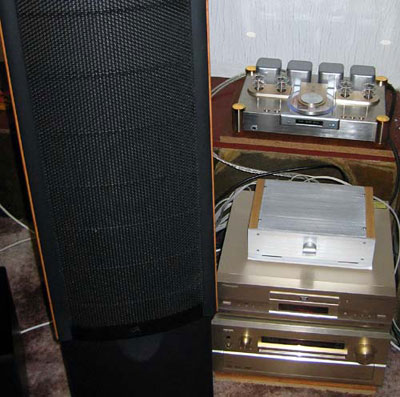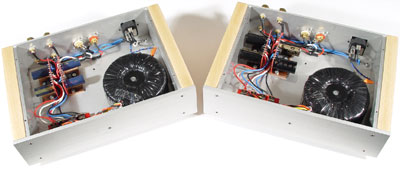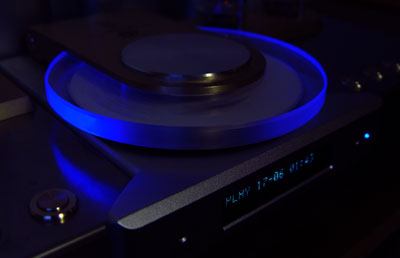First Tests
I was eager to listen to the fist amplifier and took it to a friend's house for testing. His set-up consists
of a pair of Martin Logan Ascent's and a Shanling CDT-200. The amp had been running for a few hours at
most before replacing the Denon AVC-A1SE in his set-up.
I had attached a Sfernice P11 linear pot for the volume control which was the only addition to the power amp circuit.
The immediate impression was how comfortable it appeared to drive these enormous speakers at moderate level (4 ohm nominal, 1.2 ohm ar 20kHz). We observed more
bass, a touch more clarity on the highs, and better overall imaging than the Denon.

All in all a very satisfying amp.
Blind Test Part 1
On completing both the premium and basic kit amplifiers I inserted both amps back into my friends setup
for some blind tests. Both amps were in power amp configuration (without pots) as the Shanling has a preamplifier
on board.
I had measured the DC offset of both amplifiers and was moderatly concerned as the figures were between 50mV and 120mV. To
compensate for this I added some temporary 680 ohm resistors (standard 1% types) parallel on the input which reduced the offsets to much lower
and acceptable levels.
We also decided to use the ML Scenario's instead of the Ascent's. This was due to the very narrow sweet spot of the Ascent's,
and the difficulty it brings for two people to audition in a crammed area. Moving your head 6 inches to the left/right
results in a substantial perceieved change, but this is another story... In came the Scenario's.

Both amps had been running for no more than 5 hours at moderate to low levels. For this test we made sure that neither of us knew which amp was being played at
any time.
It was difficult to identify any differences between the amps initally. It required some hard listening before we felt confident
of hearing some subtle differences. Before unmasking the amps identities,
I sincerely could not choose which I thought was the better amp, describing what was to be the basic amp as laid back, and
the premium as more bodied but a little harsh at times.
I had to conclude that it was not easy to tell the two amps apart. Perhaps some running in would allow the premium kit to shine
out more, but the immediate impression was that the premium kit was far from being superior over the basic kit, regardless of the cost.
Blind Test Part 2
There were some changes from the last setup. Firstly the ML Scenario's were replaced with the
much larger ML Ascent's as we decided there wasn't enough resolving power from the Scenario's, or enough low end capability.
There were two changes to the amp, firstly the additional 680 ohm resistor
was removed resulting back to relatively high DC offset. Secondly, a
single LED was added which draws its power from additional windings on the toroid (10 windings
with enamelled wire) and has its own recitifer bridge and capacitor.
Both amps were burned-in in parallel for a period of approximately 30-40 hours at very high volume (using
6.2 ohm power resistors on the output).
After listening to the first test track on both amps it was plain that there was still nothing major to
set the amps apart. Several tracks and amp-swappings later, and marrying up what I was hearing with my
observations from the previous test, I had an inclination that
the left amp was the premium kit and the basic kit was the right amp.

However there were some changes that allowed me to pick a preference this time.
The left amp was sharper and appeared to have a little more depth, whilst the right amp had rounded
edges in comparisson, but remained analytical with better seperation of sounds. At this point I was
feeling agitated as I had to admit that I prefered the sound of the right amp even though it appeared
to be the basic kit.
At the end of the listening we unvelied the amplifiers, and contrary to my guesses, it
was infact the premium amp that I preffered. It was evident that the burning-in had
brought about some welcome changes.
Unfortunately it would be too simple to say that it was [only] the burning-in which allowed the premium amp
to finally shine. The resolving power of the larger ML Ascent's is a big factor and the minor changes in the amp could have all
played their part too.
Furthermore, it's questionable how much of the percieved difference is attributed to the unaltered premium kit, and how
much by the addition of expensive Black Gate capacitors (which alone cost more than the basic kit).
In conclusion I would have to say that the Premium kit does appear to be the better amp. But I don't have a pair of ML Ascent's or a Shanling at my
disposal every day to appreciate the subtle differences, nor do I listen to music everyday in such a strained-ear fashion.
On a strictly price vs performance comparisson, the premium amp has nothing over the basic amp. However, the cost of both of these amps is
relatively insignifant compared to commercial amps of the same calibre. Picking the better amp is then a matter of which of these perspectives you
give more weight.
|